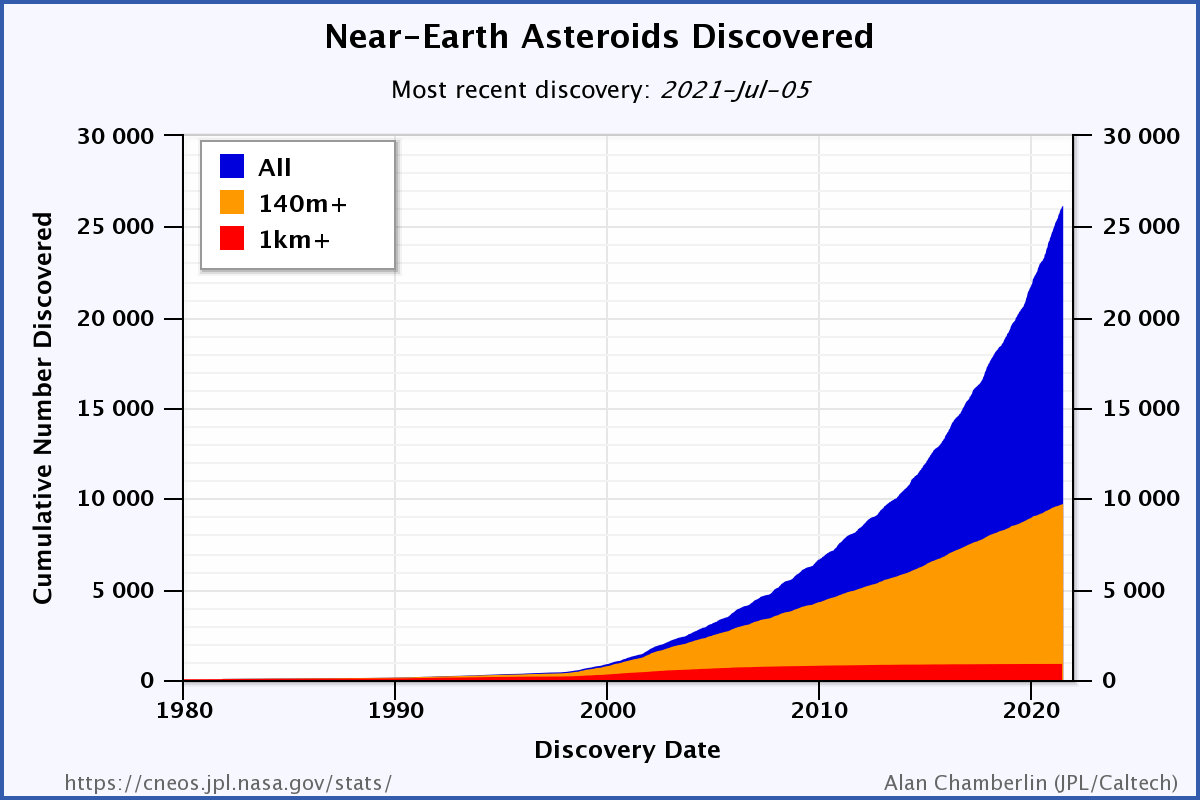
Caption: Growth of known number of NEAs and NEA-KMs (i.e., large NEAs) 1980 Jan01--2021 Jul05.
For updates, click NASA/JPL Center for Near Earth Object Studies (CNEOS, 1990s--): Discovery Statistics. See cumulative discovery graph and table at the link. The graph can be expanded to full screen in the upper right corner.
Features:
- NASA Statistics:
As of 2023
Jul06, we find:
- 32400
NEOs: i.e.,
near-Earth
asteroids and
comets.
- 32279 NEAs:
i.e.,
near-Earth
asteroids.
- 10503 NEA-140m:
i.e.,
near-Earth
asteroids
of order or greater than 140 meters
in size scale.
- 853 NEA-KMs:
i.e.,
near-Earth
asteroids
of order or greater than
1
kilometers (km) in size scale.
Variations in the definition of NEA-KMs may cause different references to give different values.
- 2343 PHAs:
i.e., potentially hazardous asteroids: i.e., those
approaching Earth
by ≤ 0.05 AU ≅ 19.5
mean lunar orbital radii
(r_earth_moon = 384402 km
= 60.2687 Earth equatorial radii
= 2.56957*10**(-3) AU)
≅ 1170
Earth equatorial radii (R_eq_⊕ = 6378.1370 km).
- 151 PHA-KMs: i.e.,
potentially hazardous asteroids
of order or greater than
1
kilometers (km) in size scale.
- 121 NECs:
i.e., near-Earth
comets. The
NEC number doesn't grow
very rapidly.
There were 40
as of 2000
Jan01.
- 32400
NEOs: i.e.,
near-Earth
asteroids and
comets.
- The NEA and
NEA-140m
curves are growing
approximately linearly
(see NASA NEO Program statistics: Totals).
This means that there are still many NEAs and NEA-140m's to discover. We are NOT beginning to exhaust the statistical population of these astro-bodies.
In fact, there is no end to the number of NEAs since one can keep looking for smaller and smaller ones. But those that are less than ∼ 1 m in size scale (which are are better called meteoroids) usually pose a relatively small threat. See Wikipedia: NEO: Impact rate and Wikipedia: Impact event: Air bursts.
- The NEA-KM curve
seems to be plateauing
(see NASA NEO Program statistics: Totals).
This means that we are nearly exhausting the NEA-KM statistical population.
Probably finding the very last NEA-KMs will take a long time since it takes an exhaustive search to find the very last ones.
- As of 2023
Jul06, NO certain
or probable Earth
impactor has been found.
Likely in the decades to come,
some will be found.
But likely they will be small and NOT dangerous---but maybe we will be unlucky.
Download site: NASA: Center for Near Earth Object Studies (CNEOS): Discovery Statistics Image link: Itself.
Local file: local link: nea_statistics.html.
File: Asteroid file: nea_statistics.html.